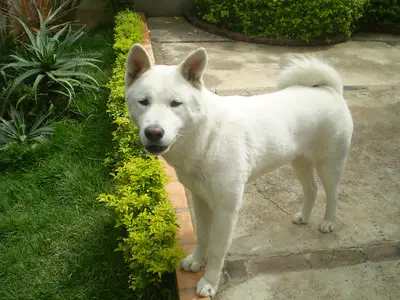
Are you looking for a new pet or are you just intrigued about this breed after meeting a Spinone Doodle for the first time?
Spinone dogs are simply adorable and quite energetic, but they make wonderful pets as they are very energetic and funny to the point of being clownish.
Apart from their need for plenty of exercise, this breed is surprisingly low maintenance, so Spinone Doodle dogs are right for people who do not have much time or appetite for grooming.
Here’s all you need to know about Spinone Doodle.
Where does the Spinone Doodle come from?
Judging by the name you’d be tempted to say it’s a novelty dog, a mix of some sort, but this is a very old breed.
This breed is also known as the Spinone Italiano and they originate from the Piedmont region in Italy. And they’re very very old. The first evidence of this type of dog goes back to 300 BC with Ancient Roman history accounts mentioning pointers with rough coats. According to these accounts, Spinone Doodles were used as hunting dogs and they were very good on harsh terrain. The name of this breed comes from the Italian term “bracco spinoso,” meaning “prickly pointer.” It’s hard to say if their original name comes from their wiry coat or from the fact that they were great at flushing game out of thorny shrubs.
From Italy, these dogs made their way to France, Spain, Greece, and even faraway Russia.
The breed’s numbers declined sharply during World War II, but Spinone lovers mounted a massive rescue operation and created a Spinone club in the 1950s.
The American Kennel Club recognized the breed in 2000.
The term Spinone Doodle might be a bit confusing as many sources refer to this breed as Spinone Italiano. The confusion can easily be explained.
The Spinone Doodle looks very much like a Labrador or a Labradoodle, although they are definitely more chunky. And there are also dogs who are a cross between pure Spinone Italiano and poodles, which seem to inherit many of the traits of the former.
Key characteristics of the Spinone
According to the AKC, modern Spinone dogs belong to the sporting group and they are truly quite the sporty type.
Ther coat comes in many colors: white, brown roan, orange roan, orange & white, but you might also find some gorgeous-looking black ones.
- Height: 22-27 inches (55-68cm)
- Weight: 61-85 pounds (27-38kg)
- Life Expectancy: 12+ years
Key traits of the Spinone Doodle
The Spinone is very energetic and his physical traits make him quite adept as a guard dog. They’re not exactly guard dogs, but they do have a distinctive bark that can keep strangers away. And, although very friendly with their immediate family, they are also quite cautious by nature and shy so an intruder would have a hard time approaching them.
Spinone dogs are sociable and docile, which makes them easy to train. Also, they are very intelligent so you won’t have to employ many hours to teach them a new command.
They are great pets for a family with children as they love to play. They are very attentive and quite tolerant with children and everyone will have a good laugh at the dog’s antiques. As with any other breed, early socializing with other animals is very important if you want to avoid conflicts later on.
Being sociable is a good thing, but your dog might suffer from separation anxiety if left on his own for many hours.
While they do tend to bark at strangers, they are not very noisy dogs. They won’t keep you awake at night with their barking and this makes them a good choice if you have neighbors living close by.
Is this the right dog for you?
Spinone dogs can very well adapt to life in an apartment, but a house with a big yard would be the perfect environment for them. Their exercise needs are rated as high so they need plenty of space to roam. If you do have a garden, make sure it has tall and secure fences. Spinone dogs are great at jumping and they will do that if intrigued by some barking on the other side of the fence and let’s not even mention a bitch in heat. Jumping is not the only problem, as they are also great at digging. If you have a beautiful flower garden, you don’t want to let a Spinone loose in it. At the very least, you should fence off the flowers or vegetables in the garden and provide the dog with a space where they can do some digging.
If you cannot provide them that, you will have to make it up to them by taking them out for long walks or to the doggy park where they can burn off some steam. Always keep your dog on a leash, not only because they’re very energetic, but also because they enjoy doing a bit of hunting like their ancestors used to. And there’s also the risk they might mistake a small animal they’re never met before for prey and start chasing it.
A Spinone needs at least two long walks per day and not just a leisurely walk. Being energetic they enjoy a good run. This makes them perfect as jogging or running companions.
Occasionally, you could also take them swimming. They love swimming and they don’t mind if the water is a bit cold. Their thick coat protects them well enough. Just don’t be near the dog when he gets out of the water and shakes off the water if you don’t want to get drenched.
If you live in an urban area and all the walk you can provide is up and down a paved street with lots of people, a Spinone might not be the right choice for you. The dog would not be able to consume his energy outside so he might wreak havoc indoors. Or your dog might get bored and start chewing everything he can get his paws on.
On the other hand, if the dog is thoroughly exhausted after some vigorous playing in the park, he’ll sleep like an angel and won’t bother you or your neighbors.
How to train a Spinone?
As mentioned above, Spinone dogs are smart and easy to train. The downside is that they’re also an independent-natured breed and may easily get distracted from training. Expecting the dog to sit in one place for long goes against its sporting nature so try to use training routines that allow the dog to move around. You need to be persistent and, of course, use rewards to get their attention. Nothing like a nice treat to make the dog eager for some training. They can easily be house-trained, but you will have to insist on obedience training. They’re quite inquisitive by nature and sometimes they might find some places or objects so interesting they’ll feel compelled to explore. Obedience is crucial, though, as you won’t be able to keep up with such an energetic dog if they decide to do a bit of ‘hunting’. Hence the recommendation to keep your dog leashed when outdoors. But you should always allow your dog to blow some steam in a fenced enclosure.
How much grooming does a Spinone need?
In terms of grooming needs, Spinone dogs rank very low. They don’t shed much and their coat doesn’t require much attention or trimming unless it bothers them in some way. Bathe as needed. Also, don’t forget the occasional brushing if only to clean the food and debris that might get trapped in the dog’s coat.
You will need to regularly maintain the ears, teeth, and nails. As they’re friendly enough you might be able to do this at home, but if you find that your dog is too energetic and cannot be bothered to sit still while you trim the nails, you might want to leave it to a professional. It’s not such a big expense as you don’t have to take him to a groomer very often. Every few months will do.
What are the main health problems affecting a Spinone?
Spinone dogs are known as a healthy breed. They’re not like brachycephalic dogs who can be plagued by many health issues. They’re not prone to some special disease, but they’re not immune to various conditions such as:
- Elbow / Hip dysplasia
- Bloat
- Cerebellar ataxia (inherited disease)
- Allergies
- Cancer
- Cataracts
- Dermatitis
- Epilepsy
What are the costs of having a Spinone Doodle?
They don’t cost much, not more than any other dogs. You will have to take into account basic expenses such as:
- Food (they’re not picky eaters)
- Veterinary care (routine checkups mostly)
- Pet insurance (optional, of course)
- Grooming ( once every few months if you cannot trim their nails at home, at least)
- Toys and equipment (give him lots of toys to keep him entertained when you’re not available)
All in all, your expenses will be somewhere between £80 and £90 a month, on average.
Where can I get a Spinone?
Try local shelters first. It’s always a good idea to adopt a dog and you might be lucky to find a purebred one end, although this breed is not quite common.
If you must buy one, avoid puppy mills. Look for responsible breeders who can provide parentage certificates and perform regular tests on their animals. You don’t want to get a puppy infected with parasites or a sickly one. It’s not only costly but also heart-breaking.





